Hospitality Industry Report: Tangible vs. Intangible Aspects Analysis
VerifiedAdded on 2023/01/19
|7
|1579
|41
Report
AI Summary
This report delves into the hospitality industry, examining the importance of both tangible and intangible aspects. It defines tangible elements as physical products and buildings, while intangible aspects encompass service quality, brand reputation, and customer experience. The study emphasizes the significance of intangible factors, especially in contexts like aged care facilities, where healthcare and service quality are prioritized. In contrast, the report highlights the tangible aspects' dominance in prison hospitality, driven by the need for robust infrastructure and basic needs fulfillment. The analysis underscores how the relative importance of these aspects varies depending on the specific setting within the hospitality sector, ultimately impacting customer satisfaction and operational priorities. The report offers a comparative analysis of these aspects, providing insights into the diverse applications within the hospitality industry.
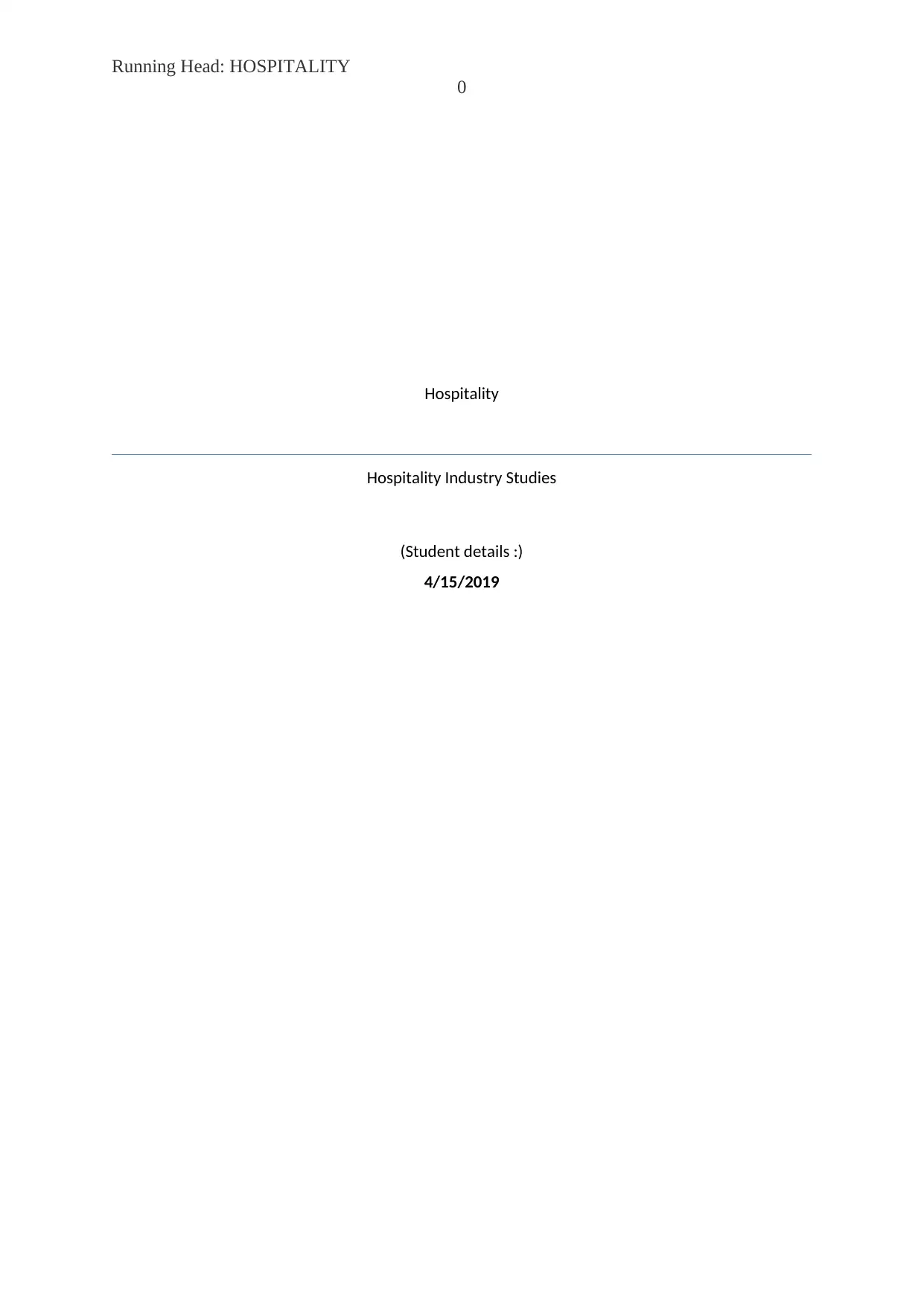
Running Head: HOSPITALITY
0
Hospitality
Hospitality Industry Studies
(Student details :)
4/15/2019
0
Hospitality
Hospitality Industry Studies
(Student details :)
4/15/2019
Paraphrase This Document
Need a fresh take? Get an instant paraphrase of this document with our AI Paraphraser
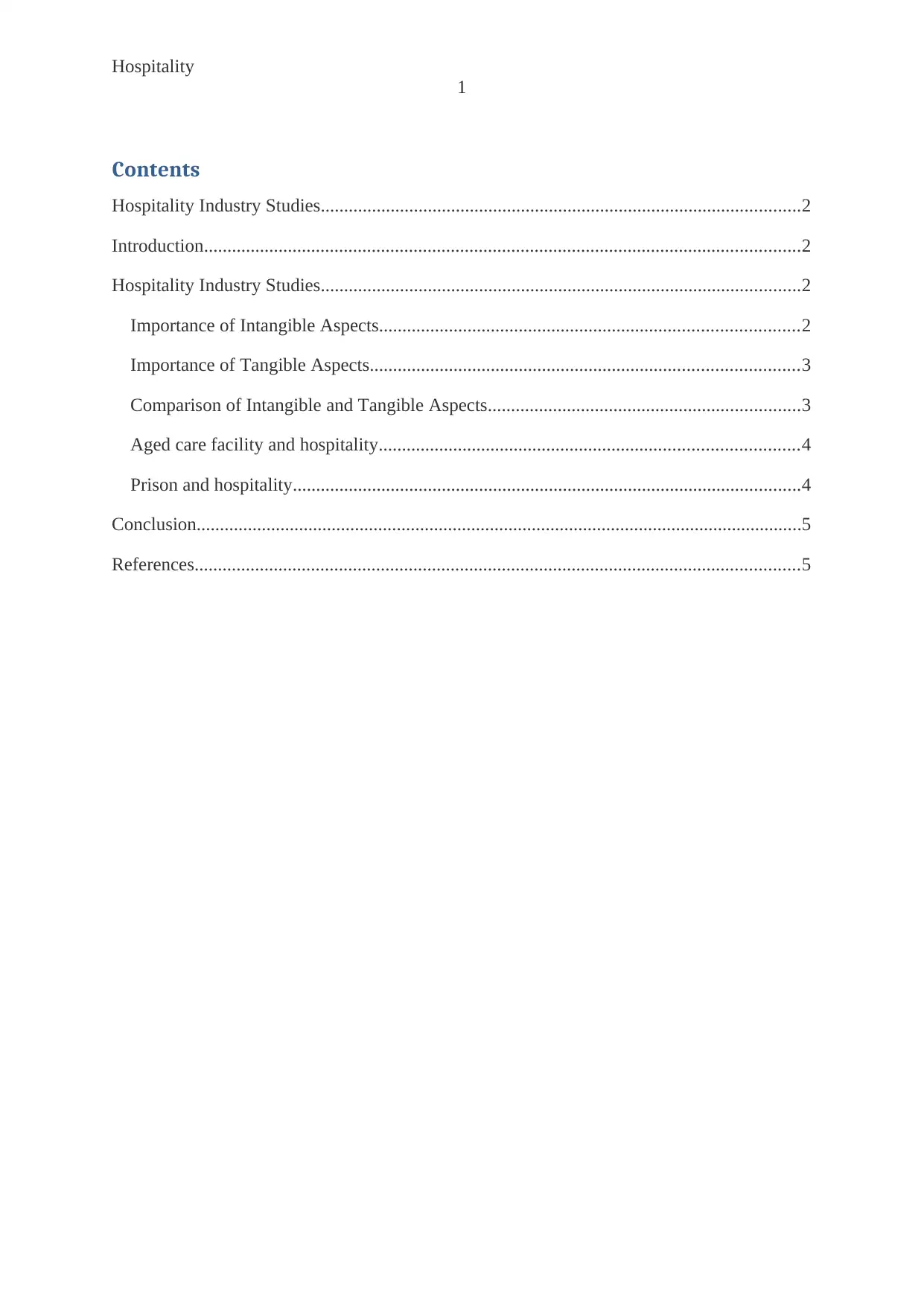
Hospitality
1
Contents
Hospitality Industry Studies.......................................................................................................2
Introduction................................................................................................................................2
Hospitality Industry Studies.......................................................................................................2
Importance of Intangible Aspects..........................................................................................2
Importance of Tangible Aspects............................................................................................3
Comparison of Intangible and Tangible Aspects...................................................................3
Aged care facility and hospitality..........................................................................................4
Prison and hospitality.............................................................................................................4
Conclusion..................................................................................................................................5
References..................................................................................................................................5
1
Contents
Hospitality Industry Studies.......................................................................................................2
Introduction................................................................................................................................2
Hospitality Industry Studies.......................................................................................................2
Importance of Intangible Aspects..........................................................................................2
Importance of Tangible Aspects............................................................................................3
Comparison of Intangible and Tangible Aspects...................................................................3
Aged care facility and hospitality..........................................................................................4
Prison and hospitality.............................................................................................................4
Conclusion..................................................................................................................................5
References..................................................................................................................................5
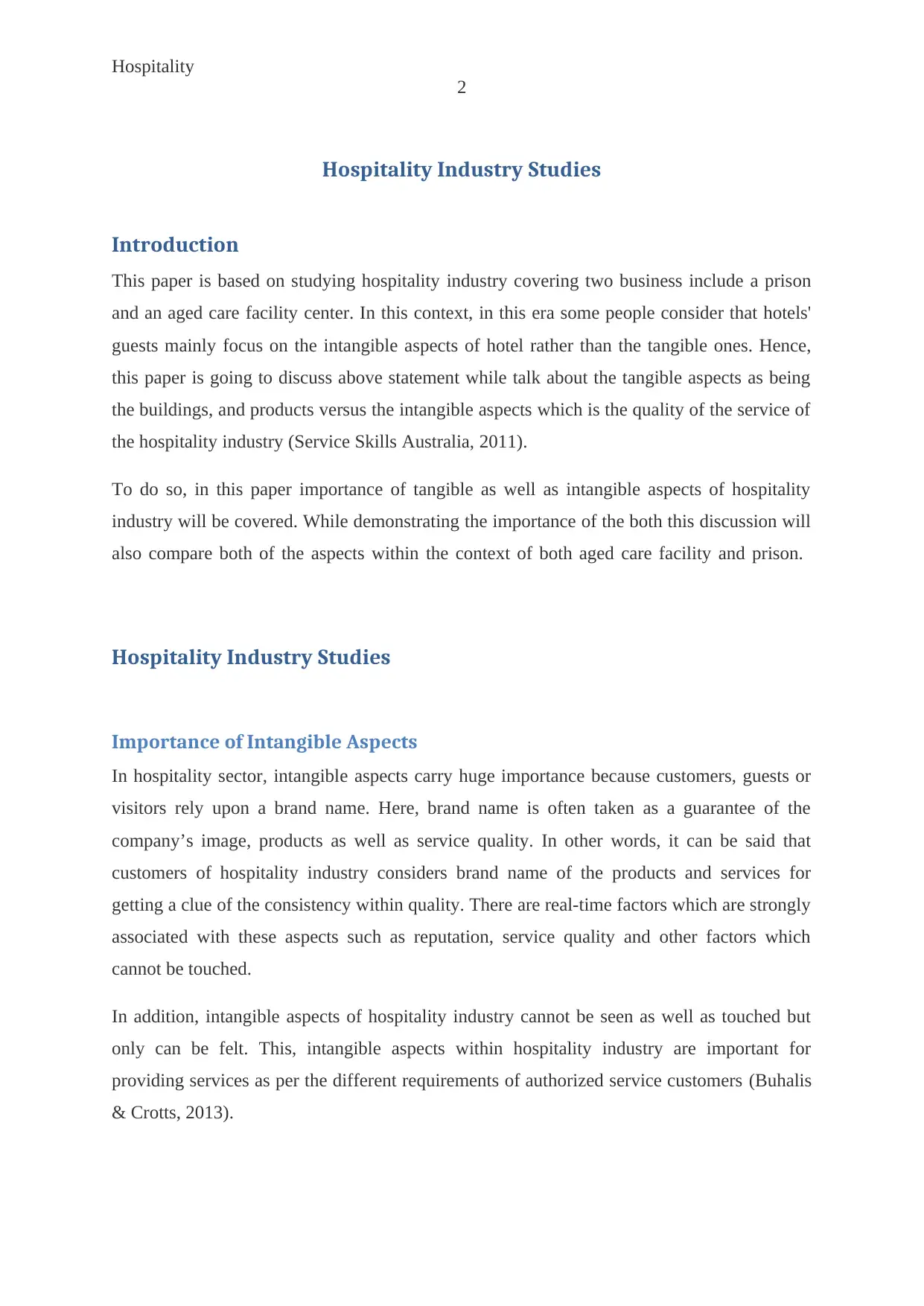
Hospitality
2
Hospitality Industry Studies
Introduction
This paper is based on studying hospitality industry covering two business include a prison
and an aged care facility center. In this context, in this era some people consider that hotels'
guests mainly focus on the intangible aspects of hotel rather than the tangible ones. Hence,
this paper is going to discuss above statement while talk about the tangible aspects as being
the buildings, and products versus the intangible aspects which is the quality of the service of
the hospitality industry (Service Skills Australia, 2011).
To do so, in this paper importance of tangible as well as intangible aspects of hospitality
industry will be covered. While demonstrating the importance of the both this discussion will
also compare both of the aspects within the context of both aged care facility and prison.
Hospitality Industry Studies
Importance of Intangible Aspects
In hospitality sector, intangible aspects carry huge importance because customers, guests or
visitors rely upon a brand name. Here, brand name is often taken as a guarantee of the
company’s image, products as well as service quality. In other words, it can be said that
customers of hospitality industry considers brand name of the products and services for
getting a clue of the consistency within quality. There are real-time factors which are strongly
associated with these aspects such as reputation, service quality and other factors which
cannot be touched.
In addition, intangible aspects of hospitality industry cannot be seen as well as touched but
only can be felt. This, intangible aspects within hospitality industry are important for
providing services as per the different requirements of authorized service customers (Buhalis
& Crotts, 2013).
2
Hospitality Industry Studies
Introduction
This paper is based on studying hospitality industry covering two business include a prison
and an aged care facility center. In this context, in this era some people consider that hotels'
guests mainly focus on the intangible aspects of hotel rather than the tangible ones. Hence,
this paper is going to discuss above statement while talk about the tangible aspects as being
the buildings, and products versus the intangible aspects which is the quality of the service of
the hospitality industry (Service Skills Australia, 2011).
To do so, in this paper importance of tangible as well as intangible aspects of hospitality
industry will be covered. While demonstrating the importance of the both this discussion will
also compare both of the aspects within the context of both aged care facility and prison.
Hospitality Industry Studies
Importance of Intangible Aspects
In hospitality sector, intangible aspects carry huge importance because customers, guests or
visitors rely upon a brand name. Here, brand name is often taken as a guarantee of the
company’s image, products as well as service quality. In other words, it can be said that
customers of hospitality industry considers brand name of the products and services for
getting a clue of the consistency within quality. There are real-time factors which are strongly
associated with these aspects such as reputation, service quality and other factors which
cannot be touched.
In addition, intangible aspects of hospitality industry cannot be seen as well as touched but
only can be felt. This, intangible aspects within hospitality industry are important for
providing services as per the different requirements of authorized service customers (Buhalis
& Crotts, 2013).
⊘ This is a preview!⊘
Do you want full access?
Subscribe today to unlock all pages.

Trusted by 1+ million students worldwide
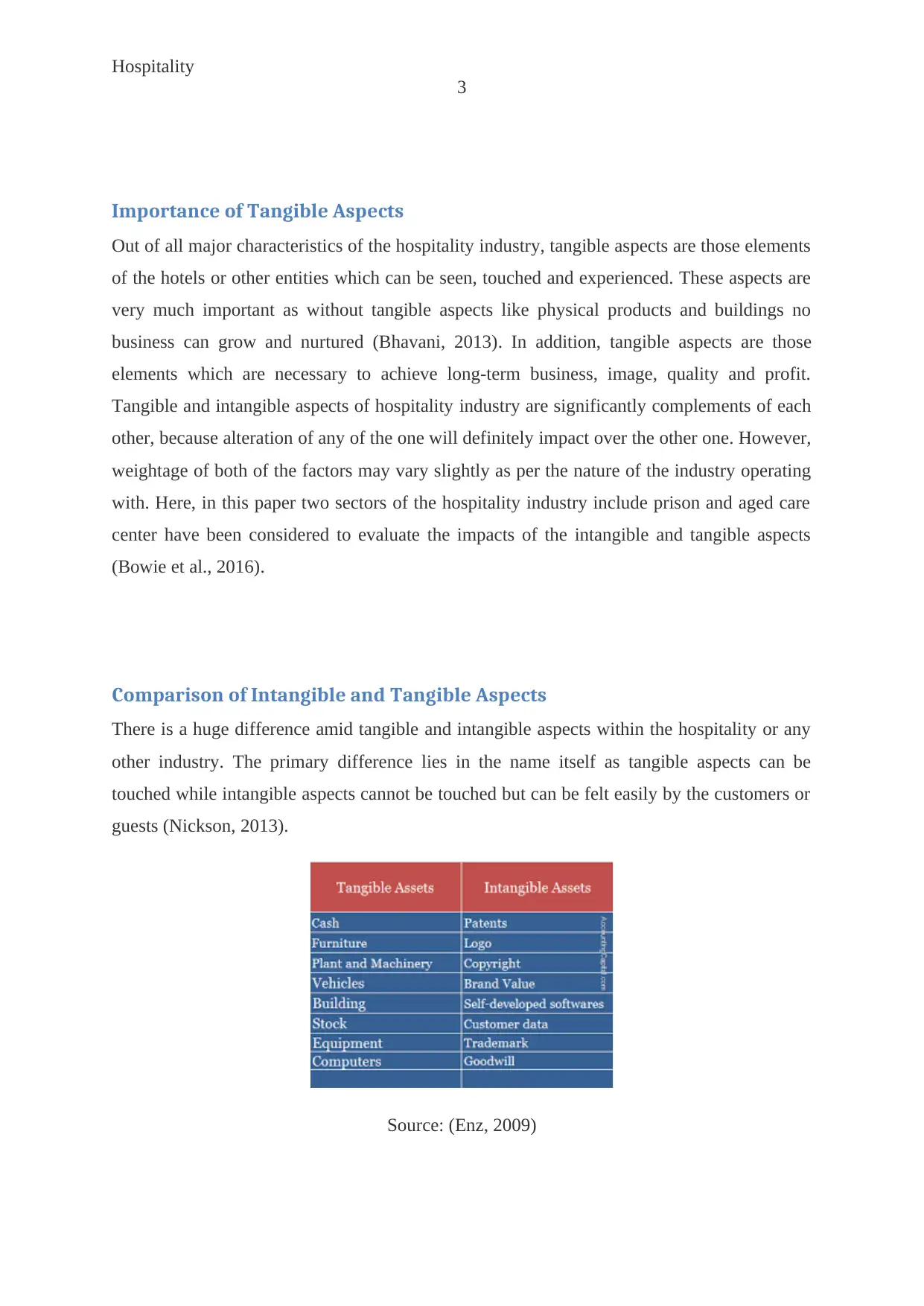
Hospitality
3
Importance of Tangible Aspects
Out of all major characteristics of the hospitality industry, tangible aspects are those elements
of the hotels or other entities which can be seen, touched and experienced. These aspects are
very much important as without tangible aspects like physical products and buildings no
business can grow and nurtured (Bhavani, 2013). In addition, tangible aspects are those
elements which are necessary to achieve long-term business, image, quality and profit.
Tangible and intangible aspects of hospitality industry are significantly complements of each
other, because alteration of any of the one will definitely impact over the other one. However,
weightage of both of the factors may vary slightly as per the nature of the industry operating
with. Here, in this paper two sectors of the hospitality industry include prison and aged care
center have been considered to evaluate the impacts of the intangible and tangible aspects
(Bowie et al., 2016).
Comparison of Intangible and Tangible Aspects
There is a huge difference amid tangible and intangible aspects within the hospitality or any
other industry. The primary difference lies in the name itself as tangible aspects can be
touched while intangible aspects cannot be touched but can be felt easily by the customers or
guests (Nickson, 2013).
Source: (Enz, 2009)
3
Importance of Tangible Aspects
Out of all major characteristics of the hospitality industry, tangible aspects are those elements
of the hotels or other entities which can be seen, touched and experienced. These aspects are
very much important as without tangible aspects like physical products and buildings no
business can grow and nurtured (Bhavani, 2013). In addition, tangible aspects are those
elements which are necessary to achieve long-term business, image, quality and profit.
Tangible and intangible aspects of hospitality industry are significantly complements of each
other, because alteration of any of the one will definitely impact over the other one. However,
weightage of both of the factors may vary slightly as per the nature of the industry operating
with. Here, in this paper two sectors of the hospitality industry include prison and aged care
center have been considered to evaluate the impacts of the intangible and tangible aspects
(Bowie et al., 2016).
Comparison of Intangible and Tangible Aspects
There is a huge difference amid tangible and intangible aspects within the hospitality or any
other industry. The primary difference lies in the name itself as tangible aspects can be
touched while intangible aspects cannot be touched but can be felt easily by the customers or
guests (Nickson, 2013).
Source: (Enz, 2009)
Paraphrase This Document
Need a fresh take? Get an instant paraphrase of this document with our AI Paraphraser
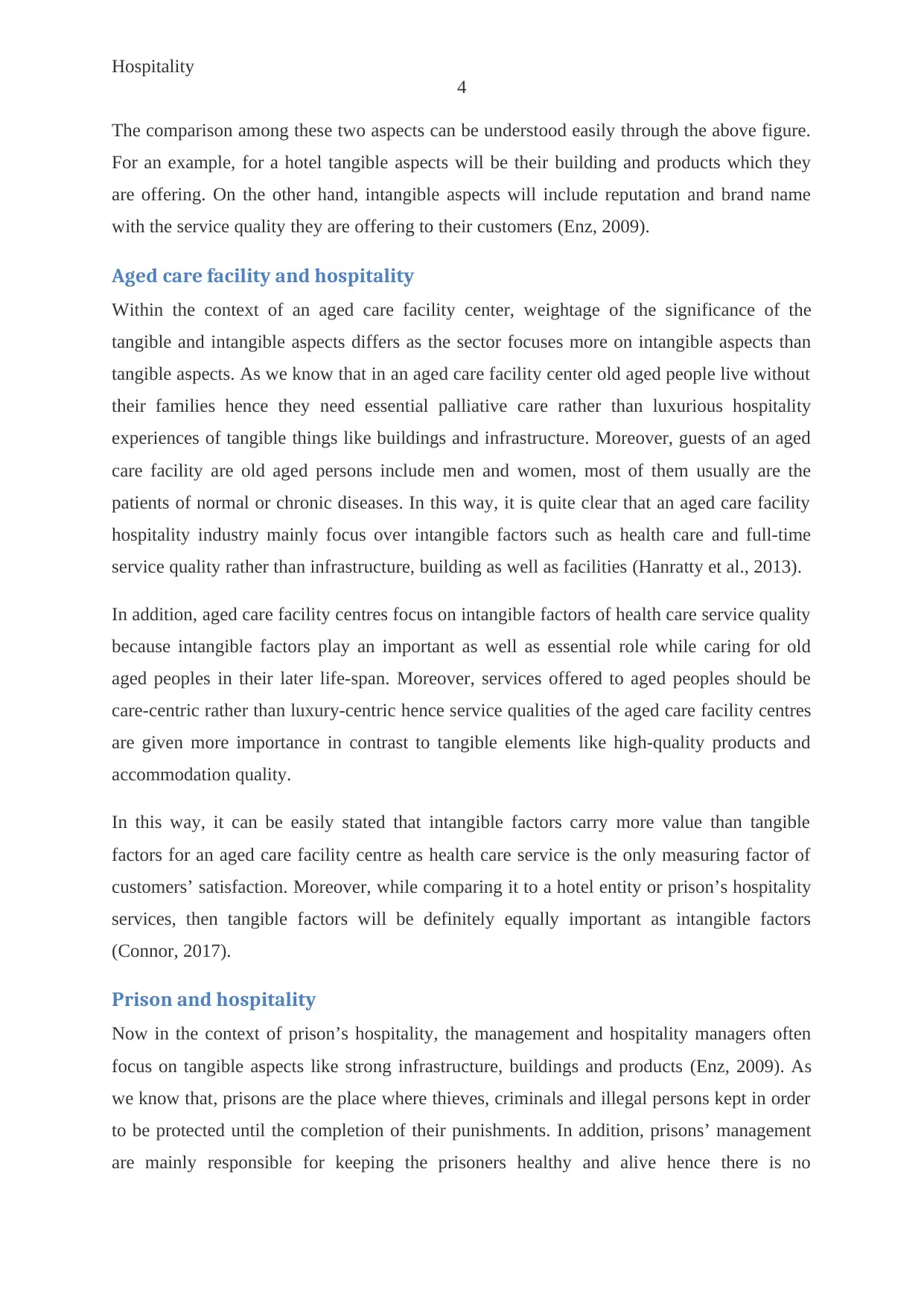
Hospitality
4
The comparison among these two aspects can be understood easily through the above figure.
For an example, for a hotel tangible aspects will be their building and products which they
are offering. On the other hand, intangible aspects will include reputation and brand name
with the service quality they are offering to their customers (Enz, 2009).
Aged care facility and hospitality
Within the context of an aged care facility center, weightage of the significance of the
tangible and intangible aspects differs as the sector focuses more on intangible aspects than
tangible aspects. As we know that in an aged care facility center old aged people live without
their families hence they need essential palliative care rather than luxurious hospitality
experiences of tangible things like buildings and infrastructure. Moreover, guests of an aged
care facility are old aged persons include men and women, most of them usually are the
patients of normal or chronic diseases. In this way, it is quite clear that an aged care facility
hospitality industry mainly focus over intangible factors such as health care and full-time
service quality rather than infrastructure, building as well as facilities (Hanratty et al., 2013).
In addition, aged care facility centres focus on intangible factors of health care service quality
because intangible factors play an important as well as essential role while caring for old
aged peoples in their later life-span. Moreover, services offered to aged peoples should be
care-centric rather than luxury-centric hence service qualities of the aged care facility centres
are given more importance in contrast to tangible elements like high-quality products and
accommodation quality.
In this way, it can be easily stated that intangible factors carry more value than tangible
factors for an aged care facility centre as health care service is the only measuring factor of
customers’ satisfaction. Moreover, while comparing it to a hotel entity or prison’s hospitality
services, then tangible factors will be definitely equally important as intangible factors
(Connor, 2017).
Prison and hospitality
Now in the context of prison’s hospitality, the management and hospitality managers often
focus on tangible aspects like strong infrastructure, buildings and products (Enz, 2009). As
we know that, prisons are the place where thieves, criminals and illegal persons kept in order
to be protected until the completion of their punishments. In addition, prisons’ management
are mainly responsible for keeping the prisoners healthy and alive hence there is no
4
The comparison among these two aspects can be understood easily through the above figure.
For an example, for a hotel tangible aspects will be their building and products which they
are offering. On the other hand, intangible aspects will include reputation and brand name
with the service quality they are offering to their customers (Enz, 2009).
Aged care facility and hospitality
Within the context of an aged care facility center, weightage of the significance of the
tangible and intangible aspects differs as the sector focuses more on intangible aspects than
tangible aspects. As we know that in an aged care facility center old aged people live without
their families hence they need essential palliative care rather than luxurious hospitality
experiences of tangible things like buildings and infrastructure. Moreover, guests of an aged
care facility are old aged persons include men and women, most of them usually are the
patients of normal or chronic diseases. In this way, it is quite clear that an aged care facility
hospitality industry mainly focus over intangible factors such as health care and full-time
service quality rather than infrastructure, building as well as facilities (Hanratty et al., 2013).
In addition, aged care facility centres focus on intangible factors of health care service quality
because intangible factors play an important as well as essential role while caring for old
aged peoples in their later life-span. Moreover, services offered to aged peoples should be
care-centric rather than luxury-centric hence service qualities of the aged care facility centres
are given more importance in contrast to tangible elements like high-quality products and
accommodation quality.
In this way, it can be easily stated that intangible factors carry more value than tangible
factors for an aged care facility centre as health care service is the only measuring factor of
customers’ satisfaction. Moreover, while comparing it to a hotel entity or prison’s hospitality
services, then tangible factors will be definitely equally important as intangible factors
(Connor, 2017).
Prison and hospitality
Now in the context of prison’s hospitality, the management and hospitality managers often
focus on tangible aspects like strong infrastructure, buildings and products (Enz, 2009). As
we know that, prisons are the place where thieves, criminals and illegal persons kept in order
to be protected until the completion of their punishments. In addition, prisons’ management
are mainly responsible for keeping the prisoners healthy and alive hence there is no
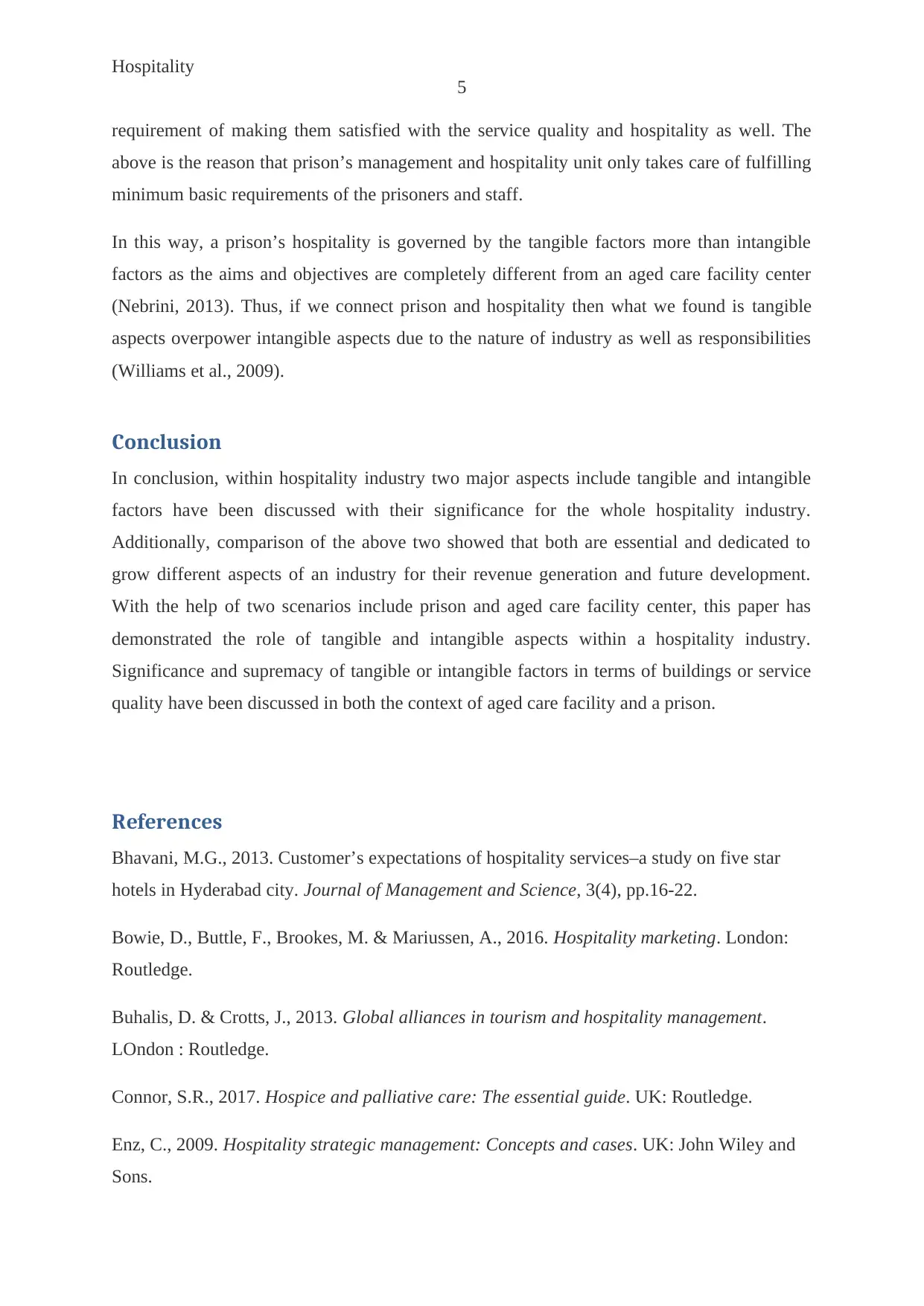
Hospitality
5
requirement of making them satisfied with the service quality and hospitality as well. The
above is the reason that prison’s management and hospitality unit only takes care of fulfilling
minimum basic requirements of the prisoners and staff.
In this way, a prison’s hospitality is governed by the tangible factors more than intangible
factors as the aims and objectives are completely different from an aged care facility center
(Nebrini, 2013). Thus, if we connect prison and hospitality then what we found is tangible
aspects overpower intangible aspects due to the nature of industry as well as responsibilities
(Williams et al., 2009).
Conclusion
In conclusion, within hospitality industry two major aspects include tangible and intangible
factors have been discussed with their significance for the whole hospitality industry.
Additionally, comparison of the above two showed that both are essential and dedicated to
grow different aspects of an industry for their revenue generation and future development.
With the help of two scenarios include prison and aged care facility center, this paper has
demonstrated the role of tangible and intangible aspects within a hospitality industry.
Significance and supremacy of tangible or intangible factors in terms of buildings or service
quality have been discussed in both the context of aged care facility and a prison.
References
Bhavani, M.G., 2013. Customer’s expectations of hospitality services–a study on five star
hotels in Hyderabad city. Journal of Management and Science, 3(4), pp.16-22.
Bowie, D., Buttle, F., Brookes, M. & Mariussen, A., 2016. Hospitality marketing. London:
Routledge.
Buhalis, D. & Crotts, J., 2013. Global alliances in tourism and hospitality management.
LOndon : Routledge.
Connor, S.R., 2017. Hospice and palliative care: The essential guide. UK: Routledge.
Enz, C., 2009. Hospitality strategic management: Concepts and cases. UK: John Wiley and
Sons.
5
requirement of making them satisfied with the service quality and hospitality as well. The
above is the reason that prison’s management and hospitality unit only takes care of fulfilling
minimum basic requirements of the prisoners and staff.
In this way, a prison’s hospitality is governed by the tangible factors more than intangible
factors as the aims and objectives are completely different from an aged care facility center
(Nebrini, 2013). Thus, if we connect prison and hospitality then what we found is tangible
aspects overpower intangible aspects due to the nature of industry as well as responsibilities
(Williams et al., 2009).
Conclusion
In conclusion, within hospitality industry two major aspects include tangible and intangible
factors have been discussed with their significance for the whole hospitality industry.
Additionally, comparison of the above two showed that both are essential and dedicated to
grow different aspects of an industry for their revenue generation and future development.
With the help of two scenarios include prison and aged care facility center, this paper has
demonstrated the role of tangible and intangible aspects within a hospitality industry.
Significance and supremacy of tangible or intangible factors in terms of buildings or service
quality have been discussed in both the context of aged care facility and a prison.
References
Bhavani, M.G., 2013. Customer’s expectations of hospitality services–a study on five star
hotels in Hyderabad city. Journal of Management and Science, 3(4), pp.16-22.
Bowie, D., Buttle, F., Brookes, M. & Mariussen, A., 2016. Hospitality marketing. London:
Routledge.
Buhalis, D. & Crotts, J., 2013. Global alliances in tourism and hospitality management.
LOndon : Routledge.
Connor, S.R., 2017. Hospice and palliative care: The essential guide. UK: Routledge.
Enz, C., 2009. Hospitality strategic management: Concepts and cases. UK: John Wiley and
Sons.
⊘ This is a preview!⊘
Do you want full access?
Subscribe today to unlock all pages.

Trusted by 1+ million students worldwide
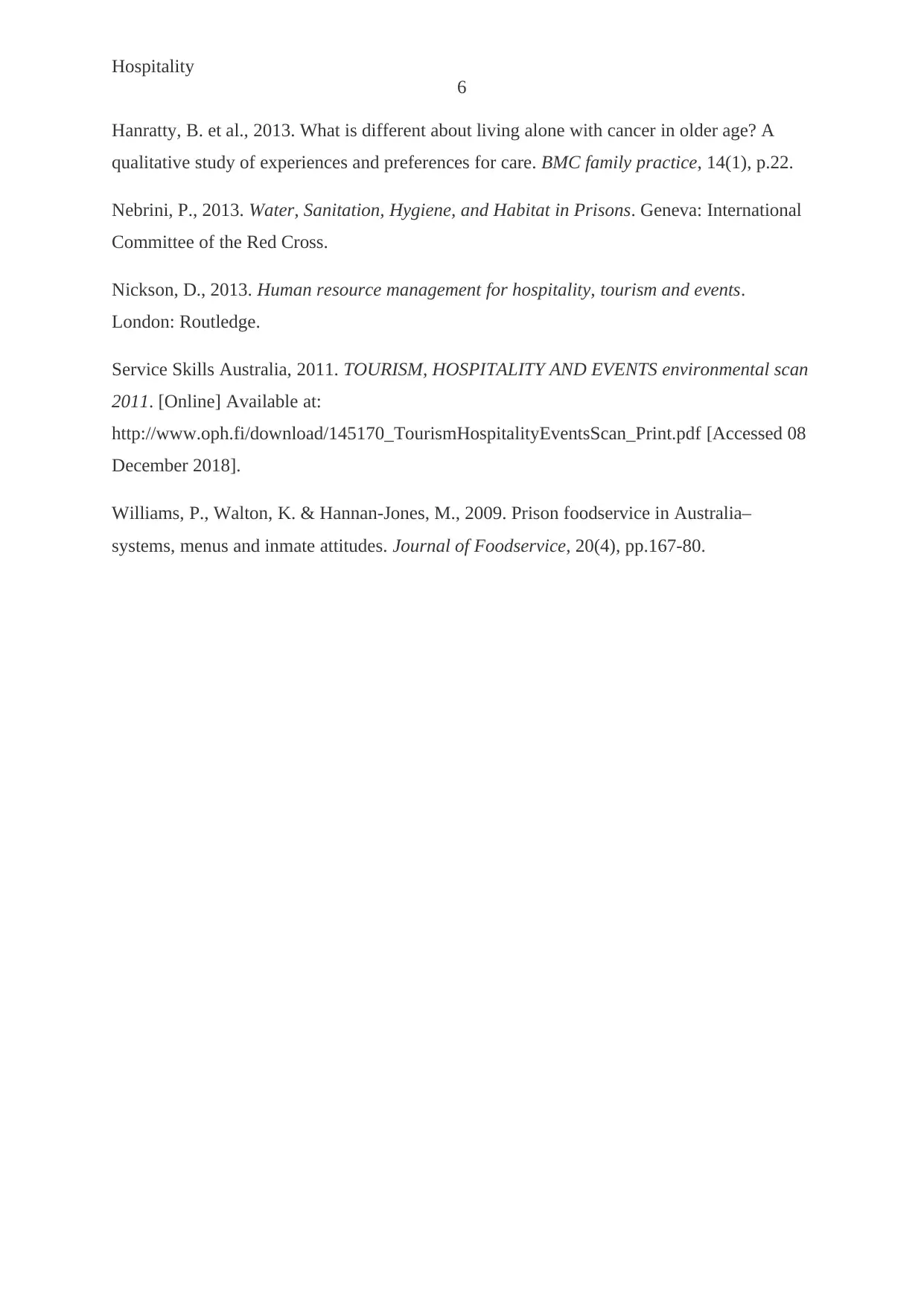
Hospitality
6
Hanratty, B. et al., 2013. What is different about living alone with cancer in older age? A
qualitative study of experiences and preferences for care. BMC family practice, 14(1), p.22.
Nebrini, P., 2013. Water, Sanitation, Hygiene, and Habitat in Prisons. Geneva: International
Committee of the Red Cross.
Nickson, D., 2013. Human resource management for hospitality, tourism and events.
London: Routledge.
Service Skills Australia, 2011. TOURISM, HOSPITALITY AND EVENTS environmental scan
2011. [Online] Available at:
http://www.oph.fi/download/145170_TourismHospitalityEventsScan_Print.pdf [Accessed 08
December 2018].
Williams, P., Walton, K. & Hannan-Jones, M., 2009. Prison foodservice in Australia–
systems, menus and inmate attitudes. Journal of Foodservice, 20(4), pp.167-80.
6
Hanratty, B. et al., 2013. What is different about living alone with cancer in older age? A
qualitative study of experiences and preferences for care. BMC family practice, 14(1), p.22.
Nebrini, P., 2013. Water, Sanitation, Hygiene, and Habitat in Prisons. Geneva: International
Committee of the Red Cross.
Nickson, D., 2013. Human resource management for hospitality, tourism and events.
London: Routledge.
Service Skills Australia, 2011. TOURISM, HOSPITALITY AND EVENTS environmental scan
2011. [Online] Available at:
http://www.oph.fi/download/145170_TourismHospitalityEventsScan_Print.pdf [Accessed 08
December 2018].
Williams, P., Walton, K. & Hannan-Jones, M., 2009. Prison foodservice in Australia–
systems, menus and inmate attitudes. Journal of Foodservice, 20(4), pp.167-80.
1 out of 7
Related Documents
Your All-in-One AI-Powered Toolkit for Academic Success.
+13062052269
info@desklib.com
Available 24*7 on WhatsApp / Email
![[object Object]](/_next/static/media/star-bottom.7253800d.svg)
Unlock your academic potential
Copyright © 2020–2025 A2Z Services. All Rights Reserved. Developed and managed by ZUCOL.





